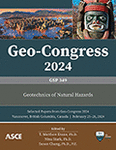Effect of Pre-Seismic History on Liquefaction Resistance of Soils Using Shaking Table Tests
Publication: Geo-Congress 2024
ABSTRACT
Liquefaction is a calamitous phenomenon that threatens the safety of infrastructure and buildings constructed in granular deposits during earthquakes. According to the response of different case histories to previous earthquakes, it has been found that the pre-seismic history significantly influences the post-liquefaction behavior of soils. To this end, a shaking table test was conducted to investigate the impact of past earthquakes or aftershocks on the liquefaction potential of saturated sands. A clean sand sample constructed in a laminar box was subjected to multiple seismic events (events A, B, and C). A series of accelerometers, pore water pressure transducer, and linear variable differential transducers (LVDT) were used to analyze the soil behavior during the shakings. The experimental results revealed that with increasing the number of shakings, settlement rate decreases due to an increase in the relative density of soil. Moreover, the excess pore water pressure (EPWP) generated during the shaking reduces as a consequence of previous shakings. Under the condition of no liquefaction, it was noted that the acceleration amplitude increases from the base to the surface of the sample.
Get full access to this article
View all available purchase options and get full access to this chapter.
REFERENCES
Bahadori, H., and Farzalizadeh, R. (2018). Dynamic properties of saturated sands mixed with tyre powders and tyre shreds. International Journal of Civil Engineering, 16, 395–408.
Boulanger, R. W., and Idriss, I. M. (2006). Liquefaction susceptibility criteria for silts and clays. Journal of geotechnical and geoenvironmental engineering, 132(11), 1413–1426.
Darby, K. M., Boulanger, R. W., DeJong, J. T., and Bronner, J. D. (2019). Progressive changes in liquefaction and cone penetration resistance across multiple shaking events in centrifuge tests. Journal of Geotechnical and Geoenvironmental Engineering, 145(3), 04018112.
Dobry, R., and Abdoun, T. (2017). Recent findings on liquefaction triggering in clean and silty sands during earthquakes. Journal of geotechnical and geoenvironmental engineering, 143(10), 04017077.
Dobry, R., Thevanayagam, S., El-Sekelly, W., Abdoun, T., and Huang, Q. (2019). Large-scale modeling of preshaking effect on liquefaction resistance, shear wave velocity, and CPT tip resistance of clean sand. Journal of Geotechnical and Geoenvironmental Engineering, 145(10), 04019065.
El-Sekelly, W., Dobry, R., Abdoun, T., and Steidl, J. H. (2016). Centrifuge modeling of the effect of preshaking on the liquefaction resistance of silty sand deposits. Journal of Geotechnical and Geoenvironmental Engineering, 142(6), 04016012.
Fiegel, G. L., and Kutter, B. L. (1994). Liquefaction mechanism for layered soils. Journal of geotechnical engineering, 120(4), 737–755.
Farzalizadeh, R., Hasheminezhad, A., and Bahadori, H. (2021). Shaking table tests on wall-type gravel and rubber drains as a liquefaction countermeasure in silty sand. Geotextiles and Geomembranes, 49(6), 1483–1494.
Finn, W. L., Bransby, P. L., and Pickering, D. J. (1970). Effect of strain history on liquefaction of sand. Journal of the Soil Mechanics and Foundations Division, 96(6), 1917–1934.
Ha, I. S., Olson, S. M., Seo, M. W., and Kim, M. M. (2011). Evaluation of reliquefaction resistance using shaking table tests. Soil dynamics and earthquake engineering, 31(4), 682–691.
Ishihara, K., and Okada, S. (1978). Effects of stress history on cyclic behavior of sand. Soils and Foundations, 18(4), 31–45.
Porcino, D., Marcianò, V., and Nicola Ghionna, V. (2009). Influence of cyclic pre-shearing on undrained behaviour of carbonate sand in simple shear tests. Geomechanics and Geoengineering: An International Journal, 4(2), 151–161.
Quigley, M.C., Hughes, M.W., Bradley, B.A., van Ballegooy, S., Reid, C., Morgenroth, J., Horton, T., Duffy, B., and Pettinga, J.R. (2016). The 2010–2011 Canterbury earthquake sequence: Environmental effects, seismic triggering thresholds and geologic legacy. Tectonophysics, 672, 228–274.
Seed, H. B., and Idriss, I. M. (1971). Simplified procedure for evaluating soil liquefaction potential. Journal of the Soil Mechanics and Foundations division, 97(9), 1249–1273.
Soroush, A., and Soltani-Jigheh, H. (2009). Pre-and post-cyclic behavior of mixed clayey soils. Canadian Geotechnical Journal, 46(2), 115–128.
Towhata, I., et al. (2014). Liquefaction in the Kanto region during the 2011 off the pacific coast of Tohoku earthquake. Soils and Foundations, 54(4), 859–873.
Wang, J., Salam, S., and Xiao, M. (2020). Evaluation of the effects of shaking history on liquefaction and cone penetration resistance using shake table tests. Soil Dynamics and Earthquake Engineering, 131, 106025.
Zeghal, M., Elgamal, A. W., Zeng, X., and Arulmoli, K. (1999). Mechanism of liquefaction response in sand–silt dynamic centrifuge tests. Soil Dynamics and Earthquake Engineering, 18(1), 71–85.
Information & Authors
Information
Published In
History
Published online: Feb 22, 2024
ASCE Technical Topics:
Authors
Metrics & Citations
Metrics
Citations
Download citation
If you have the appropriate software installed, you can download article citation data to the citation manager of your choice. Simply select your manager software from the list below and click Download.
